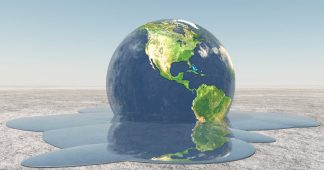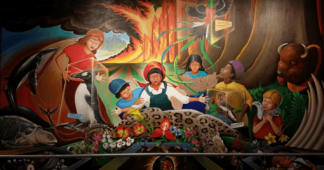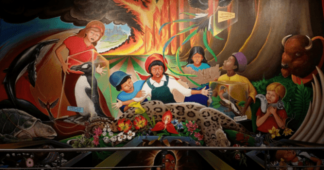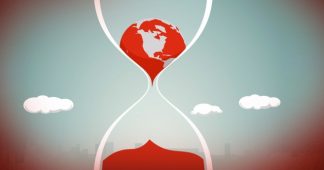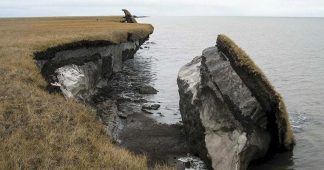August 17, 2018
An interesting new study: “Trajectories of the Earth System in the Anthropocene,” Will Steffen, Johan Rockström et al, Proceedings of the National Academy of Sciences (PNAS), Aug. 6, 2018 lays out the pathway for Earth entering a Hothouse Climate State.
“Our planet is still in danger of becoming a ‘Hothouse’ Earth despite our current efforts to manage global warming.”
Counter-intuitively, that sounds like a breath of fresh air, meaning, get the bad news out of the way ahead of time so people can brace for it, no surprises. Assuming the Hothouse Planet happens, certain areas would be uninhabitable as global temps crank up to 4C-to-5C beyond pre-industrial. The planet would be gnarled and unattractive, a nasty place to live, no more Goldilocks climate. And, all kinds of warfare would breakout as mobs vie for tillable land.
The article’s general thesis is that, as of today, the planet retains its Goldilocks “not too hot, not too cold” swagger because of a series of natural mechanisms that “maintain a balance,” for example, carbon sinks, like the ocean or like the Amazon Rain Forest keep the balance in place. In fact, the study identifies ten tipping elements that maintain a balance for the planet, any one of which, once out of whack, would cascade into all the others, bringing on the onset of a hothouse planet.
Assuming the world exceeds the 2C pre-industrial marker set by the Paris Agreement, the study envisions a dangerous out of control spiral downwards, as planetary mechanisms crash in domino fashion, resulting in a planetary climate hothouse. Maybe that’s what happened to Venus (865F, CO2 950,000 ppm) millennia ago.
According to the PNAS article, hothouse prevention is reducing carbon emissions ASAP with countries working together towards a common goal, including decarbonization, enhancement of carbon sinks, blah-blah-blah. Stop right there! The U.S. is already out of the “deal” and furthermore it’s a pipedream to assume countries will come together globally to save the planet. Since the dawn of civilization, tribes, then empires, then nation/states have been fighting like cats and dogs locked together in a crowded teeny-weeny room.
Here’s the issue as outlined by the study: It only takes one of the mechanisms to break down and topple all of the others. Ipso facto, that presents a problem today. The “tipping elements,” of which there are ten, include: (1) thawing permafrost (2) loss of coral reefs (3) loss of Arctic summer sea ice. Those three mechanisms alone, according to some pretty smart scientists, are already goners, or very, very close to goners.
What if the “tipping elements” mentioned in the study have already “tipped” or tip way ahead of plan? Then what happens, as the world grinds away towards reduction of carbon emissions whilst on the pathway to 2C? After all, scientific models have been pretty shabby now for decades, missing nasty climate events by a country mile. Time and again, the science is behind the climatic events, not ahead, not by a long shot.
Therefore, the Planet Hothouse study poses an interesting supposition: What if climate scientists have been way too optimistic, too sanguine, too upbeat and not scaring people nearly enough?
In point of fact, there’s a strong rationale for questioning the validity of climate models. For example, frequently scientists say how “surprised” they are at “how much faster things are happening than models predicted.” This happens way too often to find comfort in science models.
After several years of repeatedly hearing apologetic scientists claim the climate system is not following their models, meaning, bad stuff is happening much faster than models predicted, it becomes increasingly obvious that climate change could be closer to an out of control beast than anybody realizes. After all, the track record is all about “surprised scientists.”
The “science is late to the party” phenomena is not necessarily the fault of scientists as climate change (crisis) is on an unprecedented pathway, not following any playbooks. Come to find out, there’s no script, only models.
For example, when questioned about collapsing ice in West Antarctica, Adrian Jenkins, glaciologist, British Antarctic Survey, Cambridge said: “It was just beyond our concept that a glacier would melt that fast.”
Really! “Beyond our concept that a glacier would melt that fast!”
Helen Amanda Fricker, glaciologist, Scripps Institution of Oceanography and her team found that from 1994 to 2012, the amount of ice disappearing from all Antarctic ice shelves, not just the ones in the Amundsen Sea, increased 12-fold, from six cubic miles to 74 cubic miles per year. That was six years ago; it’s only gotten worse. Increased 12-fold… you’ve gotta be kidding…. that’s like comparing the performance of the Wright brothers to the Apollo moon landing!
“I think it’s time for us scientists to stop being so cautious about communicating the risks.” (Helen Amanda Fricker) Oh, finally, reality hits home!
The “Mass Balance of the Antarctic Ice Sheet from 1992 to 2017,” Nature, 219-222 (2018) shows the rate of ice loss from West Antarctica increasing from 53B to 159B tonnes per year. Nobody came close to predicting that in 1992, in 2002, or in 2012. No models said that would happen at that rate.
In fact, similar to the stock market, West Antarctic ice loss is in a bull market that just won’t quit, exceeding all expectations, blowing away all predictions. Not only, but two recent studies found Antarctic melt, similar to the stock market, at a “record-breaking rate.” Therefore, warning that sea level rises could have catastrophic consequences for cities. Duh!
Consider: Antarctic ice loss has accelerated threefold in the last five years; that’s a faster rate than the Dow Jones Industrial Average, which increased from 15,000 to 25,000 over the past five years or a powerhouse 67% in a raging bull market. Still, stocks look like wimps compared to Antarctica’s 5xs faster rate of ice loss. Curiously, and maybe not so coincidentally, the faster stock markets rise, the faster ice melts.
Greenland’s surface melt doubled from 1992-2011. According to Isabella Velicogna, University of California, “Nobody expected the ice sheet to lose so much mass so quickly… Things are happening a lot faster than we expected.”
“Happening a lot faster than we expected” has become the motto of climate science. “Nobody expected it to lose mass so quickly.” These expressions, or rather exasperation retorts, are indicative of a climate crisis that is rapidly galloping ahead of the science.
Maybe the Hothouse Earth study in PNAS is on-track but too late to the party.
Which begs the million-dollar question: What if 2C hits much sooner than the models expect?
Then what?
The answer is straightforward: The world turns into a hellhole much faster than the models predicted.
